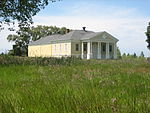The Daybreak Star Indian Cultural Center is a Native American cultural center in Seattle, Washington, described by its parent organization United Indians of All Tribes as "an urban base for Native Americans in the Seattle area." Located on 20 acres (81,000 m²) in Seattle's Discovery Park in the Magnolia neighborhood, the center developed from activism by Bernie Whitebear and other Native Americans, who staged a generally successful self-styled "invasion" and occupation of the land in 1970. Most of the former Fort Lawton military base had been declared surplus by the U.S. Department of Defense. "The claim [Whitebear and others made] to Fort Lawton was based on rights under 1865 U.S.-Indian treaties promising reversion of surplus military lands to their original owners."The existing building, a work of modern architecture incorporating many elements of traditional Northwest Native architecture, was designed by Arai Jackson Architects and Planners and completed in 1977. In 2004, plans were approved to supplement it with a complex of three additional related buildings, to be known as the People's Lodge. This was Whitebear's final dream project before he died of cancer in 2000. But in 2006, after agreements had been reached between the tribes, the city and nearby residents on a reduced size for the new project, the Center decided to postpone construction indefinitely for lack of funds.
Daybreak Star, a major nucleus of Native American cultural activity in its region, functions as a conference center, a location for pow wows, the location for a Head Start school program, and an art gallery. The center's permanent art collection includes a variety of large art works by and about Native Americans, notably Blue Jay, a 30-foot (9 m) wide, 12 foot (3.7 m) high sculpture by Lawney Reyes, Whitebear's brother. It was commissioned by and hung prominently for more than 30 years at the Bank of California building in downtown Seattle. (After the Bank of California merged with Union Bank in 1996 to form Union Bank of California, the work was donated to the Daybreak Star Center.) Also included in that donation was a major oil painting by Guy Anderson, based on a traditional Northwest Native representation of a whale.
Bernie Whitebear is memorialized by the Bernie Whitebear Memorial Ethnobotanical Garden next to the Center building.











